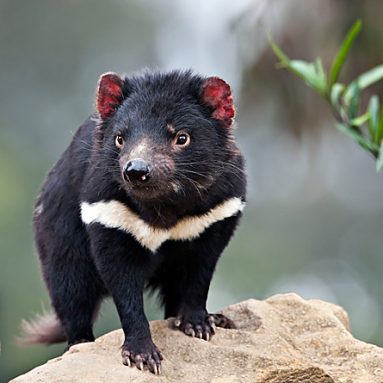The nerve of one animal
Cancer that's killing Tasmanian devils probably began in a single creature's nervous system
 |
|
A cancer that spreads from one animal to another has wiped out about 70 percent of the population of Tasmanian devils (one shown).
|
| Image courtesy of Anaspides Photography, Iain D. Williams |
A vicious cancer has wiped out 70 percent of the world’s population of wild Tasmanian devils. If nothing changes, these animals might be extinct in the wild within 30 to 50 years. But there may be hope: In a new study, scientists have identified the cancer and can point to where it starts.
Elizabeth Murchison led the study. She grew up seeing these animals in the wild. “I didn’t want to sit back and let the devils disappear,” she told Science News.
Murchison, who now works at the Wellcome Trust Sanger Institute in Hinxton, England, comes from Tasmania. It’s an Australian island that is the only native home to Tasmanian devils. These animals, which look like small bears, weigh up to 26 pounds. They have a long and bushy tail, and often feed on dead animals.
Since 1996, they have been plagued by devil facial tumor disease, or DFTD. As its name suggests, this disease causes large tumors to grow on an infected devil’s face, especially around the mouth. (Devils often bite each other on the face when they meet.) Eventually, the tumors get so large they interfere with eating. Some of these animals then die of starvation.
To make matters worse, the cancer is contagious. It’s so contagious that some scientists used to believe a virus caused the disease. But that’s not the case: Scientists have found that the cancer grows deep in the cells of the central nervous system. The cancer cells themselves spread from animal to animal through bites (although scientists still don’t know why).
Now that they know where the disease comes from, cientists might finally be able to develop a vaccine that kills the cancer before it becomes deadly, says Katherine Belov. A scientist at the University of Sydney, in Australia, she is not involved with the project.
In the study, Murchison and her team reported that the tumors start in Schwann cells. These usually surround nerve fibers. Nerve fibers, or axons, act like electrical lines in the body. They carry electrical impulses from one neuron (also known as a nerve cell) to the next, or from neurons to muscles.
When the brain sends a signal through the body, the signal travels by way of nerve fibers. Schwann cells wrap themselves around nerve fibers forming a white, wispy layer called myelin. The layer of myelin helps electrical messages zip from one nerve cell to another without shorting out. Myelin works much like insulation around electrical wires. When a Tasmanian devil’s Schwann cells become cancerous, the animal starts to grow tumors — which become contagious.
To understand the cancer, Murchison studied both healthy and tumor cells in the animals. In particular, she looked at the genes in the cells. A gene is like a set of instructions for how to build proteins, which are key ingredients that make our bodies work. All of an organism’s genes are collectively known as its genome. That genome is like a complicated recipe. In humans, it has more than 20,000 sets of instructions to create its key ingredients.
In a healthy cell, all the genes are working properly. But in a cancer cell, some genes don’t work. Some genes might be “silenced,” or turned off, like a light switch — so they’re not doing their jobs. And other genes might be doing too much of their job — making too much of some ingredient. (Think about a recipe with too much salt.)
In addition to comparing the genes of healthy and cancerous cells, Murchison looked at microRNAs. These are tiny pieces of genetic material in a cell that help determine which genes get turned on and off. She and her team studied 25 tumors and found they had the same genome (or were “genetically identical”). This led the scientists to conclude that the disease started in a single Tasmanian devil that probably got sick about 20 years ago.
She and her team also noticed that the patterns of genetic activity in the tumor cells (that is, the genetic instructions the cells were following) looked like the patterns found in Schwann cells. And that led the scientists to conclude that Schwann cells were the source.
Gregory Hannon is a scientist at Cold Spring Harbor Laboratory on Long Island, N.Y. He has worked with Murchison in the past. Right now, a vaccine that will save the Tasmanian devils is probably a long way off, he says. But that may change in a decade. “Ten years might be enough time” to save the animals, he told Science News.
POWER WORDS (adapted from the Yahoo! Kids Dictionary)
gene A hereditary unit that determines a particular characteristic in an organism.
genome The total genetic content of an organism; an organism’s genetic material.
cancer Any of various diseases with malignant cells, which tend to invade surrounding tissue and spread to new body sites.
axon (or nerve fiber) A threadlike part of a neuron that generally conducts impulses away from the body of the nerve cell.
neuron Any of the impulse-conducting cells that constitute the brain, spinal column and nerves, consisting of a cell body with a nucleus, one or more dendrites (branches that conduct impulses toward the cell body) and a single axon.
myelin A white fatty material that encloses certain axons and nerve fibers.
protein Proteins are fundamental components of all living cells and include many substances, such as enzymes, hormones and antibodies, that are necessary for the proper functioning of an organism.







